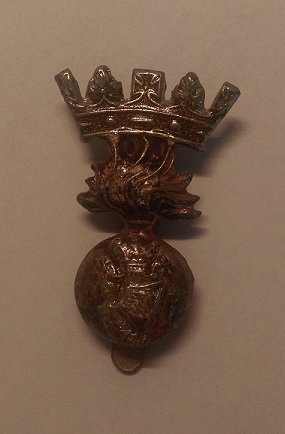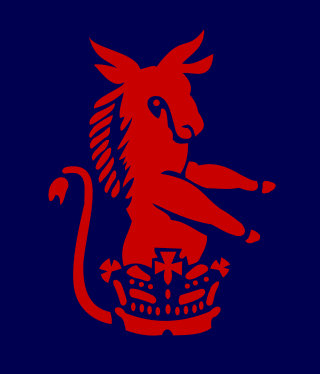Related Research Articles
The Infantry of the British Army comprises 49 infantry battalions, from 19 regiments. Of these, 33 battalions are part of the Regular army and the remaining 16 a part of the Army Reserve. The British Army's Infantry takes on a variety of roles, including armoured, mechanised, air assault and light.

The 10th (Irish) Division, was one of the first of Kitchener's New Army K1 Army Group divisions, authorized on 21 August 1914, after the outbreak of the Great War. It included battalions from the various provinces of Ireland. It was led by Irish General Bryan Mahon and fought at Gallipoli, Salonika and Palestine. It was the first of the Irish Divisions to take to the field and was the most travelled of the Irish formations. The division served as a formation of the United Kingdom's British Army during World War I.
The 36th (Ulster) Division was an infantry division of the British Army, part of Lord Kitchener's New Army, formed in September 1914. Originally called the Ulster Division, it was made up of mainly members of the Ulster Volunteer Force, who formed thirteen additional battalions for three existing regiments: the Royal Irish Fusiliers, the Royal Irish Rifles and the Royal Inniskilling Fusiliers. The division served from October 1915 on Western Front as a formation of the British Army during the Great War.

The 16th (Irish) Division was an infantry division of the British Army, raised for service during World War I. The division was a voluntary 'Service' formation of Lord Kitchener's New Armies, created in Ireland from the 'National Volunteers', initially in September 1914, after the outbreak of the Great War. In December 1915, the division moved to France, joining the British Expeditionary Force (BEF), under the command of Irish Major General William Hickie, and spent the duration of the war in action on the Western Front. Following enormous losses at the Somme, Passchendaele and Ypres, the 16th (Irish) Division required a substantial refit in England between June and August 1918, which involved the introduction of many non-Irish battalions.
The London Regiment was an infantry regiment in the British Army, part of the Territorial Force. The regiment saw service in the First World War and was disbanded in 1938, shortly before the Second World War, when most of its battalions were converted to other roles or transferred elsewhere and reformed in 1993. The London Guards date their formation to that of this Regiment in 1908.

The Royal Irish Rifles was an infantry rifle regiment of the British Army, first created in 1881 by the amalgamation of the 83rd Regiment of Foot and the 86th Regiment of Foot. The regiment saw service in the Second Boer War, the First World War, the Second World War, and the Korean War.

The Royal Inniskilling Fusiliers was an Irish line infantry regiment of the British Army in existence from 1881 until 1968. The regiment was formed in 1881 by the amalgamation of the 27th (Inniskilling) Regiment of Foot and the 108th Regiment of Foot.

The 38th (Irish) Brigade, is a brigade formation of the British Army that served in the Second World War. It was composed of North Irish line infantry regiments and served with distinction in the Tunisian and Italian Campaigns. Following the end of the war, the brigade was disbanded, but was reformed in sixty years later in 2007 and remains the regional formation for Northern Ireland.

The 36th Infantry Brigade was an infantry brigade formation of British Army that fought in the First World War, as part of 12th (Eastern) Division, on the Western Front. The brigade also fought in the Second World War, with the 12th (Eastern) Infantry Division, in France, and later with 78th Infantry Division in Tunisia and Italy.
The 167th Brigade was an infantry formation of the British Territorial Army that saw active service in both the First and Second World Wars. It was the first Territorial formation to go overseas in 1914, garrisoned Malta, and then served with the 56th (London) Infantry Division on the Western Front. In the Second World War, it fought in the North African and Italian campaigns in the Second World War.

The 29th Infantry Brigade was an infantry brigade unit of the British Army. It was originally raised in 1914 and saw service during the First and Second World Wars and the Korean War.

The Royal Irish Fusiliers (Princess Victoria's) was an Irish line infantry regiment of the British Army, formed by the amalgamation of the 87th (Prince of Wales's Irish) Regiment of Foot and the 89th (Princess Victoria's) Regiment of Foot in 1881. The regiment's first title in 1881 was Princess Victoria's (Royal Irish Fusiliers), changed in 1920 to the Royal Irish Fusiliers (Princess Victoria's). Between the time of its formation and Irish independence, it was one of eight Irish regiments.

The 107th Brigade, later 107th (Ulster) Brigade was an infantry formation of the British Army which saw service in the First World War. The brigade was later reformed during the Cold War and finally disbanded in 2006, following the drawdown of Operation Banner.

The 31st Infantry Brigade was an infantry formation of the British Army, which participated in both the First and the Second World Wars. The brigade was later reformed after the end of the war serving in the British Army of the Rhine until the end of National Service in 1956, which saw the reorganisation of the brigade as the 11th Infantry Brigade.
The 45th Infantry Brigade was an infantry brigade of the British Army that saw active service in both the First and the Second World Wars with 15th (Scottish) Infantry Division.
The 48th Brigade was a brigade of the British Army.
The 109th Brigade was a formation of the British Army during the First World War. It was raised as part of the new army also known as Kitchener's Army and assigned to the 36th (Ulster) Division. The brigade served on the Western Front.
The 178th Brigade was an infantry brigade of the British Army. The brigade saw active service during the First and the Second World Wars.
References
- ↑ "36th Division". The Long Long Trail. Retrieved 14 February 2012.